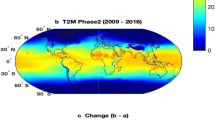Summary
The effects of both topography and urbanization on local air circulations and diffusion of pollutants are demonstrated with the help of schematic models. Based on recent assessments of the relative magnitudes of the solar radiation and some heat flux parameters a synthetic view is given of the radiative, potential, kinetic, thermodynamic, and air hygienic interrelationships. Comparison with other local circulation systems reveals that due to the more complicated thermal structure the urban circulation system does not reverse at night as do shoreline and valleys winds.
Zusammenfassung
Mit Hilfe von Modellen wird der Einfluß von Topographie und Verstädterung auf lokale Windsysteme und die Schadstoffausbreitung dargestellt. Neuere Untersuchungen über die relativen Größenordnungen der einzelnen Sonnen- und Wärmestrahlungselemente gestatten eine Gesamtschau der engen strahlungsenergetischen, potentiellen, kinetischen, thermodynamischen und lufthygienischen Verflechtungen. Ein Vergleich mit anderen lokalen Windsystemen zeigt, daß infolge der komplizierteren thermischen Struktur das städtische Zirkulationssystem im Gegensatz zu See- und Talwinden nachts nicht entgegengesetzt verläuft, sondern immer zur Stadtmitte hin gerichtet ist.
Résumé
On démontre, au moyen de modèles, l'influence de topographie et d'urbanisation sur la circulation atmosphérique locale et sur la diffusion des viciateurs. Des recherches récentes sur les grandeurs relatives de la radiation solaire et des éléments du flux de chaleur ont permis d'établir synthétiquement les relations directes de la radiation, du potentiel, de la cinétique, de la thermodynamique, et de l'hygiène de l'air. Une comparison avec les autres systèmes de la circulation atmosphérique locale montre qu'en raison de sa structure thermique plus complexe, le système de la circulation urbaine, en contraste avec les vents des vallées et des côtes, se dirige toujours vers le centre de la ville.
Similar content being viewed by others
References
American Soc. of Heating, Refrigerating, and Air Conditioning Engineers, ASHRAE Guide and Data Book, Applications, New York, 645–656 (1968).
Bach, W., andW. Patterson: Heat Budget Studies in Greater Cincinnati. Prcdgs. Assoc. Amer. Geogr.1, 7–11 (1969).
Baumgartner, A.: Untersuchungen über den Wärme- und Wasserhaushalt eines jungen Waldes. Ber. Deut. Wetterd.5, No. 28, 53 pp. (1956).
Berg, H.: Der Einfluß einer Großstadt auf Bewölkung, Niederschlag und Wind. Biokl. Beibl.10, 65–70 (1943).
Budyko, M. J.: The Heat Balance of the Earth's Surface (1956). (Engl. Transl. from the Russian by U. S. Dept. of Commerce, Washington, D. C., 1958.)
Chandler, T. J.: The Climate of London. London: Hutchinson, 1965.
Cincinnati Gas and Electric Annual Report (1967).
Emonds, H.: Das Bonner Stadtklima. Arb. z. Rhein. Ldskde., H. 7 (1954).
Flohn, H.: Climate and Weather. New York: World Univ. Lib. McGraw-Hill, 1969.
Garnett, A., andW. Bach: An Estimation of the Ratio of Artificial Heat Generation to Natural Radiation Heat in Sheffield. Mo. Wea. Rev.93, 383–385 (1965).
Garnett, A., andW. Bach: An Investigation of Urban Temperature Variations by Traverses in Sheffield (1962–1963). Prcdgs. 3rd. Int. Biomet. Congr., pt. 2, 601–607 (1967).
Geiger, R.: The Climate Near the Ground. Cambridge, Mass.: Harv. Univ. Press, 1965.
Hoffmann, G.: Wärmehaushalt und Advektion. Arch. Met. Geoph. Biokl., A,11, 474–502 (1960).
House, G. J., et al.: A Surface Energy-Balance Computer. Q. J. R. Met. Soc.86, 215–231 (1960).
Landsberg, H.: City Air—Better or Worse? Symp. on Air Over Cities. Sec. Tech. Rep. AG 2-5, PHS, 1–22 (1961).
Lauscher, F., undF. Steinhauser: Strahlungsuntersuchungen in Wien und Umgebung. Sitzungsber. Akad. Wiss. Wien, Math. Naturwiss. Kl. Abt. 2a,141, 15–32 (1932), und143, 175–196 (1934).
Lowry, W. R.: The Climate of Cities. Scientif. Amer.271, 15–23 (1967).
McMullen, T. B. et al.: Air Quality and Characteristic Community Parameters. Air Poll. Contr. Assoc. J.18, 545–549 (1968).
Middleton, J. T.: Future Air Quality Standards and Motor Vehicle Emission Restrictions. Prcdgs. 3rd Nat. Conf. on Air Poll., Washington, PHS 45-54 (1967).
Miller, D. H.: A Survey Course. The Energy and Mass Budget at the Surface of the Earth. Assoc. of Amer. Geogr., Commission on College Geography, Publ. No. 7, 1968.
Munn, R. E.: Descriptive Micrometeorology. Advances Geoph., Suppl. 1, New York: Academic Press, 1966.
Ozolins, G., andR. Smith: A Rapid Survey Technique for Estimating Community Air Pollution Emissions. USDHEW, PHS Publ. No. 999-AP-29, Cincinnati, Ohio, 1966.
Sellers, W. D.: Physical Climatology. Chicago: The Univ. of Chicago Press, 1965.
Slade, D. H. (ed.): Meteorology and Atomic Energy 1968. U. S. Atomic Energy Commission, Div. of Techn. Information, Oak Ridge, Tenn., 1968.
Smith, M. (ed.): Recommended Guide for the Prediction of the Dispersion of Airborne Effluents. Amer. Soc. Mech. Eng., New York, 1968.
Swan, J. B., et al.: Economical Radiometer Performance, Construction, and Theory. Soils Bull.4, Univ. of Wisc., Madison, 1961.
Tanner, C. B.,et al.: Economical Radiometer Theory, Performance and Construction. Res. Rep.40, Res. Div., Coll. Agr. and Life Sciences, Univ. of Madison, 1969.
U. S. Dept. of Commerce, U. S. Census of Housing, 1960.
U. S. Dept. of Commerce, Fuels and Electric Energy Consumed in Manufacturing Industries, 1963.
Author information
Authors and Affiliations
Additional information
With 2 Figures
Rights and permissions
About this article
Cite this article
Bach, W. An urban circulation model. Arch. Met. Geoph. Biokl. B. 18, 155–168 (1970). https://doi.org/10.1007/BF02243024
Received:
Issue Date:
DOI: https://doi.org/10.1007/BF02243024




